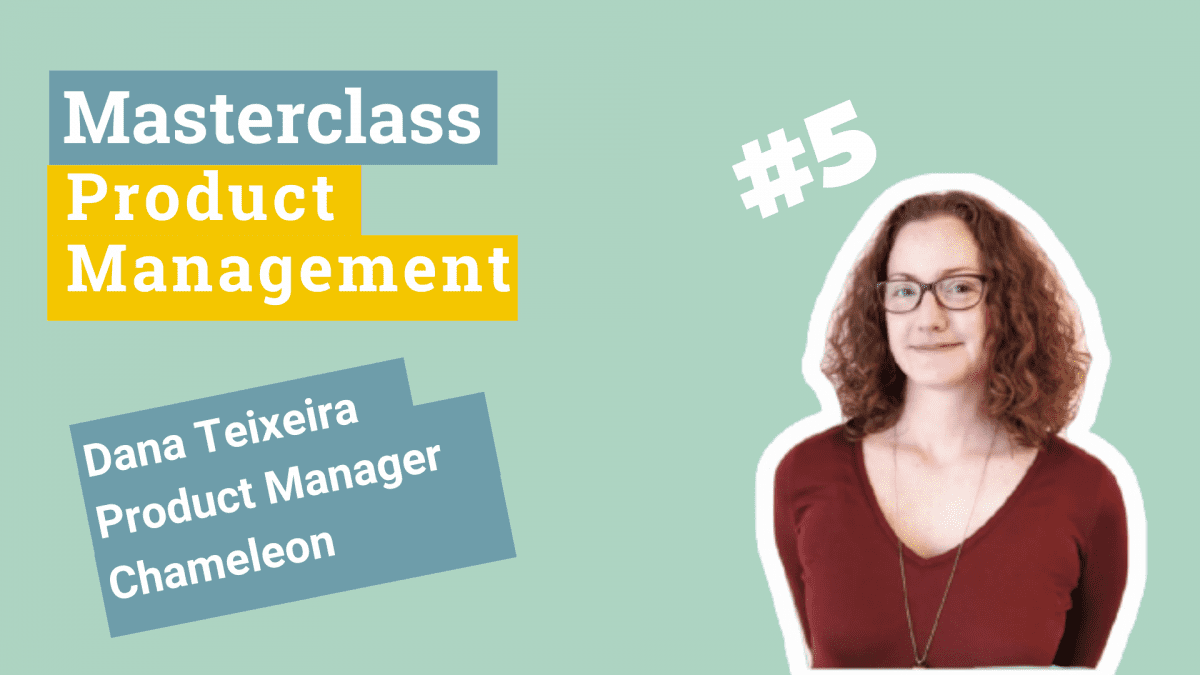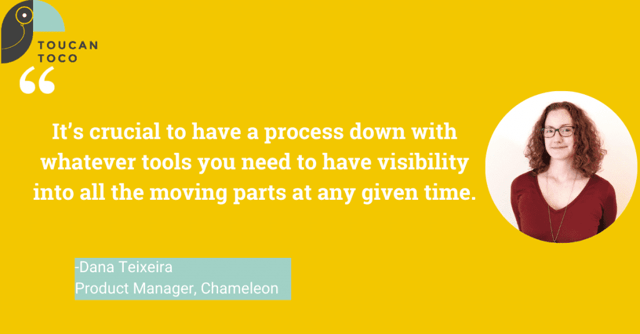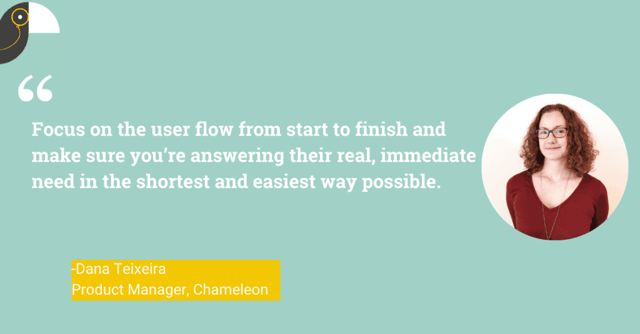
1. Tell us a bit about yourself!
Hello! I’m Dana Teixeira, and I’m a Product Manager at Chameleon. My career has been an interesting blend of Business Analysis and Product Ownership, between small startups, mid-sized agencies and large corporations. A love of travel has seen that career help organization in Chicago, USA, to Wellington, New Zealand, to Melbourne, Australia, and now remotely from where I currently live in Nantes, France. As a fan of science fiction, I’m always asking “what if…?”, which lends to pretty thorough spec documentation and looking for edge cases to cover, as well as imagining where we can take our product next. Outside of work, I create illustrations in traditional ink or digital mediums and also enjoy hiking. You can connect with me on LinkedIn.
2. In one word or one sentence, how would you describe your product management style?
My goal is to set others up for success; If someone is stuck, there’s likely a solvable reason why.
3. How did you get into product management?
One of my first jobs out of university was doing graphic design and some light front end web development for a major publishing company as they made the switch to digital. Infographics (data and stats communicated by beautiful illustrations) were newly popular, and I printed them out and decorated the walls of my cubicle with them as both a knowledge resource and something to liven up my office space. My managers saw this as having expertise in subjects like responsive web design and social media, so they started inviting me to more decision-making and planning meetings. Paired with my natural inclination to be outspoken, they recognized my potential and promoted me to oversee our graphics team. I worked with a recruiter for my next role, and he introduced me to a startup in Chicago that needed a Project Manager. It felt intimidating at the time, but ended up being a perfect fit!
4. What are one or two things you typically do during the first hour of your day that lead to a productive day?
I often do my best thinking and planning when I’m away from the screen. So, I’ve started to check in early in the morning to address whatever notifications I missed overnight (I’m in the European half of our team and coordinate with the Americas half of our team in my afternoon). This gives me a preview of what’s in store for my day: What interruptions I might need to re-prioritize or where I need to help nudge things along. I’ll open a new page in my daily work diary and make a list of what I want to accomplish (or reconcile outstanding items from the previous day). Then, since I tend to work later to overlap with US time zones, I’ll take a break to enjoy my coffee and free time, and get back to it after. I think the break between seeing what’s on my plate and actually working on it helps me formulate a plan and confirm what I should focus on; Kind of like finally realizing the solution to a problem while in the middle of taking a shower!
5. What’s one of your biggest challenges in product management today?
Working lean means working small and fast, which means it can feel like individual features don’t get the full attention and time you want to give them. It’s a challenge to balance what’s technically possible with what your customers need, and with what’s small enough to address those needs quickly without disrupting too much of the rest of your product or process.
Keeping tabs on several smaller projects is also a larger mental load than just one large project. It’s crucial to have a process down with whatever tools you need to have visibility into all the moving parts at any given time.
6. How can PMs stay ahead of user requirements or make sure they’re aware of them early?
I believe a blend of constant contact with your customers (both in 1-on-1 conversations and through analytics or survey feedback) and, hate to say, experience, will help PMs stay on top of requirements. The more features you’ve worked on or products you’ve released, the more edge cases or possible enhancements you can be aware of in advance, and you’ll know the exact kinds of questions to ask (both to your customers and your development team) to ensure you’re covering all your bases.
7. How would you prioritize your resources when you have two important things to do but can’t do them both?
This question comes up a lot (and it’s usually three, or four, or five important things…) and there are multiple ways of answering it. But rarely does a PM wake up in the morning and discover two brand new, never-before-discussed, important issues to resolve on their desk: Every product or feature has plenty of history and context around it that will be used to decide how to approach it.
So, I would start by digging into that context. Are these issues coming from customers, and if so which customers? Do we risk losing one of our biggest advocates if we don’t resolve this?
Does this issue impact our other work? Will this issue block development, or is it a security risk that exposes us to more problems if left unchecked? Maybe our dev team will be fine ignoring it a bit longer, but our Sales team is losing ground being unable to answer prospect questions about why we don’t have a particular feature.
What are we currently working on? Does something we already have in progress resolve one of these issues, or can minor adjustments be made to tackle it? Is there anything else we can bump to deal with later in order to address this issue?
And finally, thinking outside the box: Maybe you can split your dev team in half to keep one side of development going while the other side addresses your important issues. Maybe there are other ways to resolve it, like using a third-party application or offering a customer discount or bonus features to keep them on board while their problem is being resolved. Maybe the “important thing” is a problem of misunderstanding, and an improved help article, video tutorial, or blog will address it.
There are few perfect formulas to follow that will dictate how you respond to competing issues, but asking questions and getting the context behind them is always the best place to start.
8. What qualities make a good product? Any tips and tricks for our readers for building a better product?
I’ve been thrilled with products that look absolutely terrible but get what I need to do done in a straightforward and intuitive way. Making a product look clean and polished can absolutely lend towards its intuitiveness, but I would focus on the user flow from the start to finish and make sure you’re answering their real, immediate need in the shortest and easiest to understand way possible.
Testing your product on people who have never experienced it before is an excellent way to check how intuitive it is. Whether you can find fresh eyes to test it, collect feedback soon after a new customer joins, or even ask your new hires to poke around and give their honest take on it, collecting those raw perceptions will help you understand how usable your product is even after you’ve gotten used to seeing and using it yourself.
9. What aspects of product management do you find the most exciting? The least?
I genuinely love knowing I’ve helped make the work for someone else on my team easier. By listening to others and asking them to describe how they work, you can find ways to get ahead of where their pain points are. I enjoy bridging the gaps in communication across different teams, while also ensuring we’re not bogged down in meetings.
There’s a lot of pressure in feeling like the team’s organization and success are on your shoulders; If you have a bad day and “drop the ball” it can have cascading effects that you need to quickly resolve. But part of what I enjoy about smaller teams is we recognize the team effort involved and help out where we can even if it’s outside of our usual work. We take mistakes as opportunities to learn and improve, which makes our work better in the long run.
10. Tell me about how you interact with customers/users?
I’ve interacted with customers with varying degrees of technical expertise, so I focus on speaking in layman’s terms or using metaphors when describing technical solutions. I also focus more on what our customers’ pain points are and what their goals are: It’s our job to sort out the path to get there. It may sound silly, but I’ve often asked customers to imagine a wizard came by with a magical wand to fix their issue and to tell me what the end result looks like. They may describe something that’s not possible, but it reveals a lot about what will make their lives easier, and you can gradually scale back the “magic wand” abilities and arrive at what’s a feasible and still powerful solution.
11. What is one best practice you’ve adopted/applied in the last few months that had a positive impact on your role? How has it helped you?
I think most product managers are praised for multitasking, but I’ve been making it a point to truly focus on one task at a time unless something really pressing comes up. I only leave open the tabs and apps I absolutely need for whatever I’m working on at the moment, and wait until it’s complete or I’m in a good place to switch to something else before fully closing and moving on. I still accomplish “multiple tasks” throughout the day, but they each get the attention and diligence they deserve.
I’ve also been keeping a daily work diary to track what I’ve accomplished throughout the day, and to write to-do lists either at the end of the day for me to start on the next, or in the morning once I’ve reviewed my emails and notifications that I got overnight. This helps me self-assess where and how I’m spending my time and gives me confidence that I can pause to focus on one issue at a time like I have been, knowing that I’ve already planned what I need to address next.




